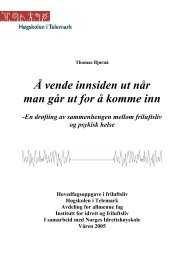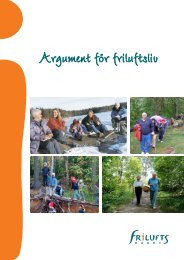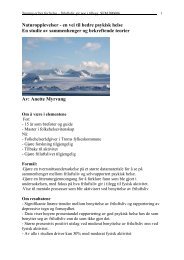Green Care: A Conceptual Framework - Frisk i naturen
Green Care: A Conceptual Framework - Frisk i naturen
Green Care: A Conceptual Framework - Frisk i naturen
You also want an ePaper? Increase the reach of your titles
YUMPU automatically turns print PDFs into web optimized ePapers that Google loves.
mental and social facets. Overall health is experienced as the sum of all of<br />
the facets of health at any one time. The perceived health state is a dynamic<br />
process which is affected by individual meanings. In the model, health can<br />
be improved either by enhancing positive health or by reducing negative<br />
health, or doing both.<br />
The objective of the therapeutic use of green care is to reduce ill-health.<br />
It can consist of horticultural therapy, animal-assisted therapy and other<br />
therapeutic activities, which are targeted to heal conditions related to<br />
ill-health. Stress and attention fatigue can be seen as incapacitating states<br />
of human body; so the recovery provided by green environments is<br />
therapeutic.<br />
Well-being has two dimensions: true well-being and fitness. True wellbeing<br />
is related to the empowerment of individuals based on autonomy<br />
and feeling of well-being. Coping resources and possibilities to use one’s<br />
capabilities contribute to autonomy. <strong>Green</strong> care provides many possibilities<br />
to exert control over events and situations and offers opportunities for free<br />
choice and development of skills.<br />
Fitness is related to an individual’s physical capacity to cope with the<br />
demands of the environment. <strong>Green</strong> care can be used to increase the<br />
compatibility between the individual and the environment by providing the<br />
opportunity for physical activity and exercise in accessible and supportive<br />
surroundings.<br />
The suggestion based on the model of Downie et al, (2000), that health<br />
can be promoted not only by preventing ill-health but also by enhancing<br />
well-being and fitness, is in accordance with the salutogenic approach<br />
described by Antonovsky (1988), in which factors maintaining good health<br />
are emphasized (Rappe, 2005). In Antonovsky’s theory a strong sense<br />
of coherence maintains good health by providing resources to manage<br />
everyday strain. A sense of coherence can be achieved when stimuli derived<br />
from the environment are comprehensible, manageable and meaningful for<br />
an individual.<br />
Outcomes<br />
The outcomes of green care are difficult to prove, especially when a<br />
biomedical disease-oriented construct of health is used. The use of a<br />
102 <strong>Green</strong> <strong>Care</strong>: A <strong>Conceptual</strong> <strong>Framework</strong>















